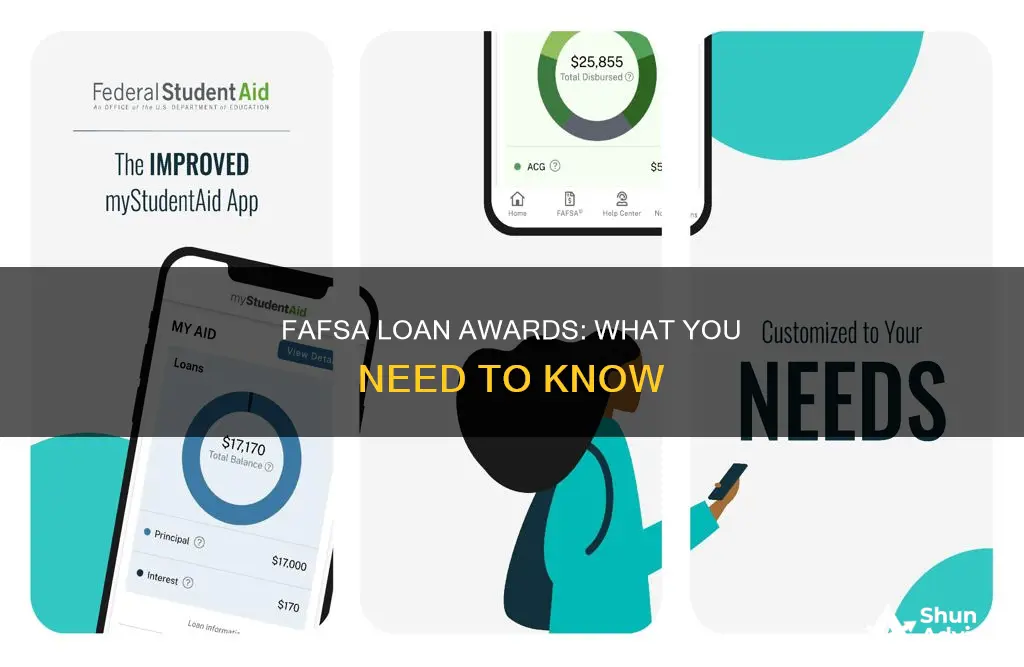
The Free Application for Federal Student Aid (FAFSA) is a form that students in the US can fill out to apply for financial aid for college. The FAFSA requests information about the student's and, if applicable, their parents' or legal guardian's financial situation. The FAFSA application opens on October 1 of every year, and it must be completed annually. The information provided in the application is used by states, colleges and universities, and private scholarship programs to determine eligibility for financial aid. The types of aid that may be received include federal student loans, grants, and work-study funds.
| Characteristics | Values |
|---|---|
| Purpose | To determine how much financial aid a student is eligible to receive. |
| Types of financial aid | Federal student loans, grants, and work-study opportunities. |
| Eligibility | Students must be U.S. citizens or eligible noncitizens enrolled in an eligible certificate or degree program at a college or university. |
| Application process | Students or their families fill out the FAFSA form, providing information about their financial situation. |
| Award amount | Depends on the college or university the student plans to attend and their financial need. |
| Repayment | Federal student loans must be repaid after graduation, while grants do not need to be repaid. |
| Appeal | Students can appeal the financial aid decision if they believe they are eligible for more aid. |
| Deadlines | The FAFSA application opens on October 1 of each year. |
| Frequency | Students must complete the FAFSA annually to remain eligible for financial aid. |
What You'll Learn

Federal student loans
The Free Application for Federal Student Aid (FAFSA) is a form that students or their families use to apply for financial assistance for college from the federal government. The FAFSA is used to determine eligibility for federal student loans, which typically have more favourable terms than loans from private lenders and offer a variety of flexible repayment options.
The FAFSA asks a series of questions about the parents' and student's income and assets, as well as other factors, such as how many children there are in the family. This information is used to calculate a Student Aid Index (SAI), which determines the amount of financial aid a student is eligible to receive. The FAFSA must be completed each year, as the financial aid award amount may change over time due to changes in financial status or income.
After submitting the FAFSA, students will receive a Student Aid Report with information about the potential financial aid they can receive from their school. This report will include details on the number of grants and federal loans the student is eligible for, as well as any work-study opportunities. The financial aid package offered by the school will be based on the student's cost of attendance, which includes tuition, fees, and other costs such as food, housing, and transportation.
It is important to note that the FAFSA award may not cover all educational expenses. If the financial aid package is not sufficient, students can appeal the decision and provide supporting documentation to justify their request for more aid. Students can also explore other funding sources, such as scholarships, grants, and private student loans, to help bridge the gap between their financial aid award and the cost of attendance.
Loans and Financial Intermediaries: An Inevitable Partnership?
You may want to see also

Grants
The Free Application for Federal Student Aid (FAFSA) helps students get federal and state financial aid, including grants and student loans. Most families are eligible for some form of federal financial aid for college. The FAFSA is used to apply for financial assistance for college from the federal government, and states, individual colleges and universities, and private scholarship programs also rely on the information provided in the application.
To determine a family's financial need, the FAFSA asks a series of questions about the parents' and student's income and assets, as well as other factors, such as the number of children in the family. It then comes up with a Student Aid Index (SAI). In terms of assets, the FAFSA assumes that 20% of a student’s assets and 5.64% of the parents’ assets should be available for spending in any one college year.
Explore Loan Recast Options: Not All Lenders Are Equal
You may want to see also

Work-study opportunities
The Federal Work-Study (FWS) Program is a form of financial aid that provides eligible students with part-time employment to help pay for their educational expenses. The program is available at around 3,400 colleges and universities, and students can apply by submitting the Free Application for Federal Student Aid (FAFSA).
To be eligible for the FWS program, students must meet the general eligibility criteria and demonstrate financial need. Schools must make FWS jobs available to all eligible students and consider factors such as the student's financial need, the number of hours they can work, the anticipated wage rate, and the amount of other assistance available. The FWS program does not require that priority be given to students with exceptional financial need.
Students who are awarded FWS can work during periods of non-attendance, such as summer terms, and the money earned does not need to be repaid. The earnings from FWS jobs are also not calculated into the FAFSA, so they won't reduce a student's eligibility for other forms of financial aid. Undergraduate students with FWS jobs are paid by the hour at least once a month, and all jobs pay at least the federal minimum hourly wage.
After submitting the FAFSA and receiving an offer for work-study, students must then find, apply, and secure a work-study job. Many colleges and universities provide online job portals that list open positions for qualifying students. Students may need to attend an interview and agree to a set of responsibilities and a schedule if hired.
MPN Student Loans: Who Needs to Fill Them Out?
You may want to see also

School-based merit aid
Completing the FAFSA is crucial for students seeking financial aid for college. The FAFSA, or the Free Application for Federal Student Aid, is the official form that students or their families use to apply for financial assistance from the federal government. It is used to determine a family's financial need by asking questions about the parents' and student's income and assets, as well as other factors such as family size.
While most financial aid is offered based on financial need, there is another category of aid called merit-based financial aid. This type of aid is awarded in recognition of student achievements, such as academic, athletic, or artistic accomplishments. Merit-based financial aid, also known as merit scholarships or merit awards, can significantly reduce the total cost of college.
- Not every school offers merit-based financial aid. Selective colleges, such as those in the Ivy League, typically distribute financial aid based solely on a student's financial need.
- Schools that meet the full financial need of their students will cover the entire gap between the cost of attendance and the amount the family can contribute, as determined by the FAFSA. These schools focus on ensuring that all students can afford to attend, regardless of their financial circumstances.
- To maximize your chances of receiving school-based merit aid, it is important to fill out the FAFSA as soon as it becomes available on October 1 of each year. This will give you access to the most aid opportunities.
- In addition to academic achievements, schools may consider other factors such as test scores, artistic skill, athletic ability, or other accomplishments when awarding merit-based scholarships.
- Some colleges may have specific requirements or guidelines for their merit-based scholarships, so it is important to research and understand the criteria for each school you are interested in.
- Merit-based financial aid can come from sources other than the college itself. Some states offer merit-based aid programs, and there are also outside scholarship organizations that recognize student achievements. For example, Massachusetts residents may be eligible for the John and Abigail Adams Scholarship.
Exit Counseling: Impact on Loan Disbursement?
You may want to see also

Private student loans
FAFSA (Free Application for Federal Student Aid) is the official form that students or their families use to apply for financial assistance for college from the federal government. Filling out the FAFSA is the first step in applying for federal student loans, which are offered by the government. Federal student loans typically have more favourable terms than loans from private lenders and offer a variety of flexible repayment options.
When applying for a private student loan, your credit—and your cosigner’s credit—will be evaluated, along with other information provided on your application. Applying with a creditworthy cosigner may increase your chances of approval and help you get a better rate. Online applications are typically easy and straightforward, with some lenders providing a credit result in about 10 minutes.
It's important to evaluate all anticipated monthly loan payments and expected future earnings before considering a private student loan. Loan comparison sites like Credible can help you find loans that match your criteria and provide prequalified rates from multiple lenders without impacting your credit score.
How EFC Affects Unsubsidized Stafford Loan Eligibility
You may want to see also
Frequently asked questions
FAFSA stands for Free Application for Federal Student Aid. It is used to apply for financial assistance for college from the federal government.
FAFSA covers federal student loans, grants, and work-study opportunities.
The FAFSA application opens on October 1 of every year. You can submit the FAFSA form online or by paper.
The amount of money you receive from FAFSA depends on your financial need and the cost of attendance. Your financial aid award may not cover all of your educational expenses, so you may need to explore other funding sources as well.







